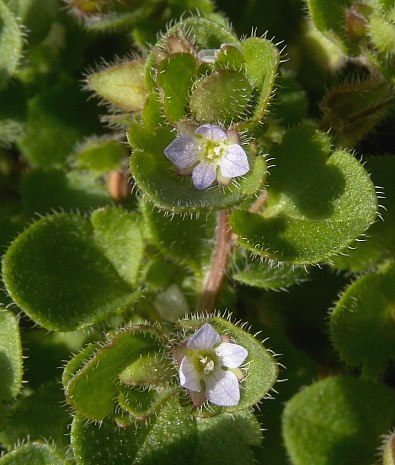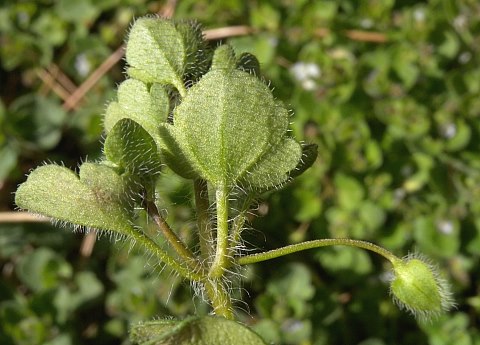
Individual flowers develop across from the alternate leaves on slender pedicels about ¼-1" long. These pedicels are light green and short-pubescent. Individual flowers are about 1/8" across, consisting of a pale purple corolla with 4 spreading lobes, 4 green to reddish green sepals that are almost as long as the corolla, 2 stamens with white anthers, and a 2-celled ovary with a single short style. The corolla has several fine veins that originate from its center; they are a darker shade of purple. The sepals are cordate-ovate in shape, pubescent along their outer sides, and conspicuously ciliate along their margins. The blooming period occurs from mid- to late-spring for about 2 months; some plants may bloom
Cultivation: The preference is full or partial sun, more or less mesic conditions, and soil (possibly acidic) containing loam, sand, or gravel. This little plant can spread aggressively by reseeding itself.
Range & Habitat: The non-native Ivy-Leaved Speedwell is uncommon in southern Illinois, while in the rest of the state it is rare or absent. It may be more widespread than what is indicated by these distribution records, however. This weedy wildflower was introduced accidentally into North American from Europe. Habitats consist of grassy slopes, fields, roadsides, and waste ground. Areas with a history of disturbance are preferred.
Faunal Associations: The nectar of the flowers attracts Andrenid bees (Andrena spp.), Halictid bees (Halictus spp., Lasioglossum spp.), and miscellaneous Syrphid flies. Insects that feed on the foliage or suck plant juices from Veronica spp. include the stink bug Cosmopepla lintneriana, the ebony bug Corimelaena pulicaria, and the flea beetle Longitarsus turbatus. The seeds are probably consumed by sparrows and other birds, but there is a lack of records to substantiate this. Cattle and other mammalian herbivores occasionally feed on the foliage of these plants without apparent ill-effect.
Photographic Location: On ground that was partially shaded by a pine tree at the Arboretum of the University of Illinois in Urbana, Illinois.

Comments: This is one of several Veronica spp. from Europe that are weedy annuals and they prefer similar habitats. Ivy-Leaved Speedwell can be distinguished from similar species by a combination of the following characteristics: 1) only non-terminal solitary flowers are produced along its stems, rather than terminal or non-terminal racemes, 2) the pedicels of its flowers (or seed capsules) are about as long as the leaves, rather than shorter than the leaves, 3) the margins of its leaves have 3-5 blunt lobes or crenate teeth, and 4) its stems, petioles, leaf margins, and sepal margins have conspicuous long hairs, rather than short inconspicuous hairs or a lack of hairs. This latter characteristic provides Ivy-Leaved Speedwell with a bristly appearance. An alternative spelling for the scientific name of this plant is Veronica hederifolia.